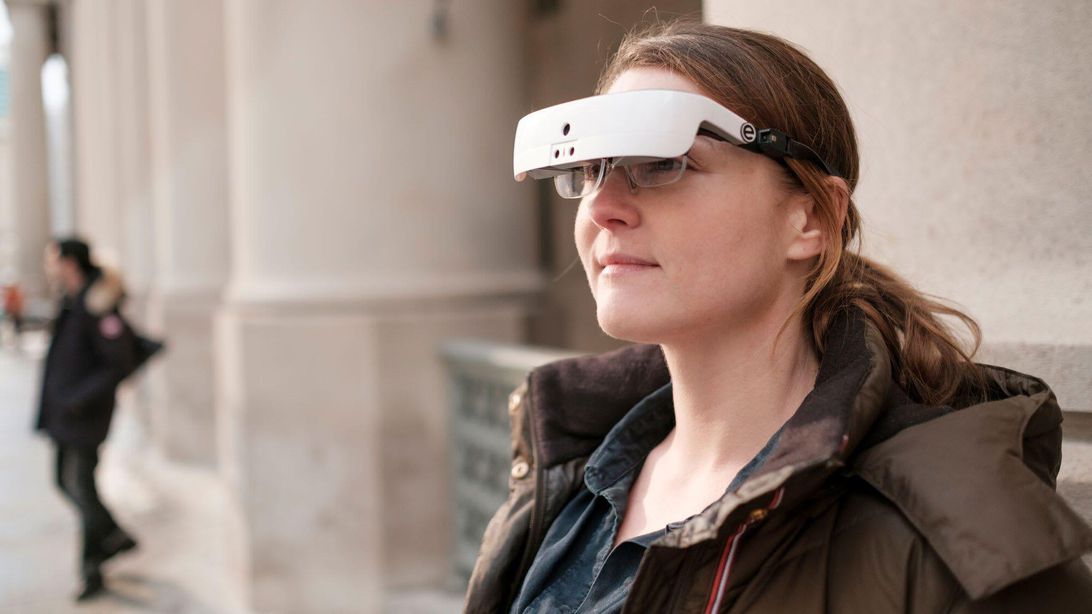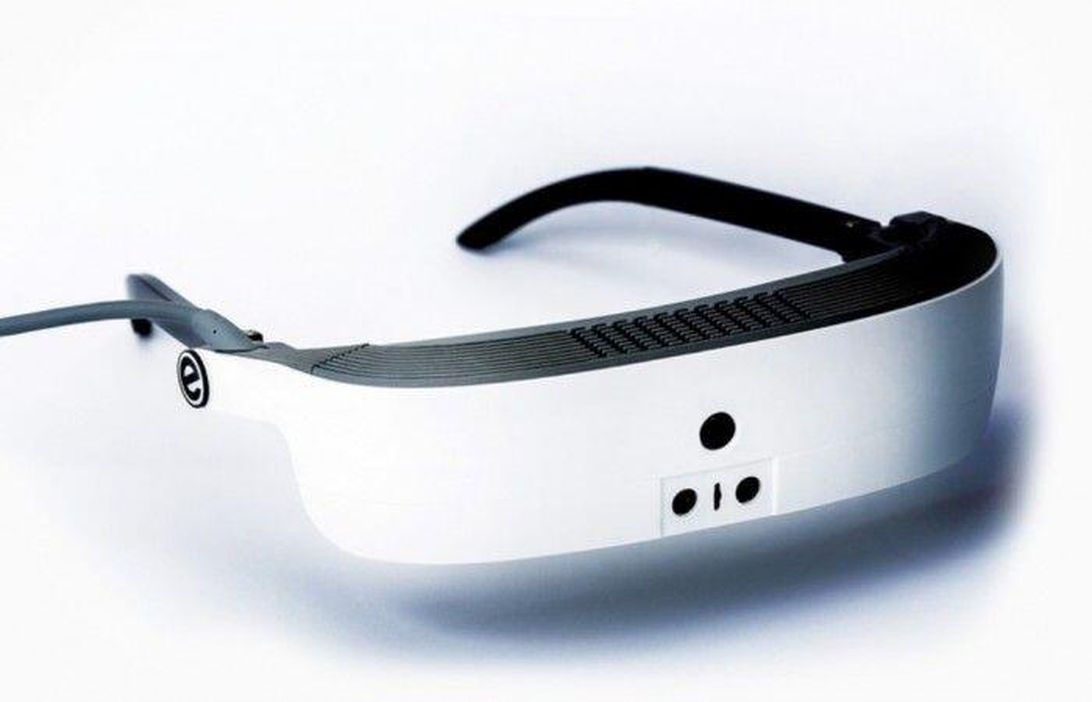This device helps blind veterans see
A company that makes a high-tech medical device to help the visually impaired see is working with blind and low-vision veterans to help them regain independence.

About 130,000 US veterans are legally blind, and more than 1 million veterans live with low vision that causes a loss of ability and independence in performing necessary daily activities, according to the Blind Rehabilitation Services at the US Department of Veterans Affairs. In October, vision platform organization eSight announced the approval of eSight 3, the third generation of the company's sight-enhancing glasses for those living with visual impairments, on the VA Federal Supply Schedule -- giving sight-impaired veterans access to a high-tech medical device that can help them see and regain independence.
Bob Vaters, CEO of Toronto-based eSight, is quick to correct the use of the word "glasses" to describe the product. He prefers the word "device." And it's not hard to see why.
"They are far more powerful," Vaters said. "There's far more technology involved than to simply call them glasses."
It's true. The device uses high-resolution screens, smart algorithms and a cutting-edge camera to help a low-vision individual see more clearly, with the ultimate goal of living more independently.
Classified as a Type One FDA-approved medical device, the eyewear provides a nonsurgical, wearable system that functions by stimulating synaptic activity from the remaining photoreceptor function in the user's eyes. This can provide the brain with increased visual information to naturally compensate for gaps in the user's field of vision. My wire-framed glasses with plastic lenses can't do any of that.
Vaters is also cautious about the company being included in any glasses programs with reimbursements, which don't really play to the benefits that eSight's wearable medical device provides. "Down the road, we may have multiple tiers of strategy that relate to what could become 'glasses' as opposed to what the 'device' is now," Vaters said. "So we're very adamant about calling it an AR [augmented reality] device."
The tech behind the device
eSight 3 is a wearable that works to enhance sight for people with central vision loss -- when your vision looking straight ahead is blurred, and only side vision remains. The outer portion of the device is made of different types of rigid, rugged plastic that allows for a smooth, high-quality texture without forfeiting stability for comfort.
"The actual device itself is powered by one of the most advanced mobile chips out there, and can do a lot of features, including connectivity," said Charles Lim, eSight's chief technology officer. "So basically it's like a supercomputer on your head, if you want to think of it that way."

Lim runs the company's technology and operations team. Before eSight, he worked for Imax, the big-screen cinema chain, running one of its business units. He's worked for eSight for 18 months and said the work he's doing has been rewarding.
In 2019, eSight participated in an event with Dell, the computer giant. During the event, parents of children who had started using one of eSight's devices approached Lim crying because their children could see for the first time.
"I've told my friends, 'Look, I've done cameras for the NASA Hubble telescope, spacecraft and the shuttle Discovery; I've done broadcasts, fiber optics and GPS. But none of them have ever cried or shook my hand for any of the things that I've done for them,'" Lim said.
Lim explained that eSight designed its vision-enhancing device with three factors in mind: improved sight, mobility and vision control. The device has an adjustable strap that fits a variety of head sizes, allowing for external customization.
The company's medical devices typically retail for $6,000, a steep investment for veterans and other low-vision individuals who may be living on a fixed income.
Vaters estimates that there are 66 million people worldwide who have low vision who could benefit from eSight's product, but a large percentage of them can't afford it. "So one of the best things for us to do is make an argument to the major payers in the United States," he said, "and show them the difference between what the current cost of treatment is for macular degeneration and our devices."
The VA's Federal Supply Schedule program negotiates firm-fixed pricing based on a commercial "most favored customer" pricing concept, including an option for economic price adjustments. In other words, by partnering with the Veteran's Administration, eSight is able to offer veterans who qualify a much more financially accessible alternative enabling improved vision. It's also far less invasive, as low-vision individuals often need surgery to restore their ability to see.
The impact of COVID-19
Despite its efforts, the company hasn't been impervious amid the coronavirus pandemic.
eSight's production facility is in Ottawa, and a few months ago, Lim was struggling to manage its supply chain, which sourced many of its device materials from China. But with help from the company's global partners and senior leadership, it was able to mitigate the worst of the crisis and found a new path forward, Lim said, potentially shortening the supply chain by manufacturing materials in Canada.
In addition to supply chain issues, some of eSight's employees have been displaced due to the outbreak, including Vaters, who is staying in Canada while his family is in New York. However, since most of their corporate staff works remotely, even before the shelter-in-place orders, and the majority of its sales are on site, making eSight better prepared to weather the crisis.
"The actual IT systems are all relatively cloud-native already," Lim said, "which means that our users and our actual employees can access them from anywhere as long as they have internet access."
eSight also created #eSightTogether, an online community for people with low vision to access COVID-19-elated resources. The digital campaign provides a place for connectivity, daily virtual events, such as a Daily Coffee Chat at 11 a.m. PT (2 p.m. ET), through which members can connect with each other and share stories during the pandemic.
The global pandemic is making both Vaters and Lim consider applications of eSight's wearables that they never thought about before. "You know, the whole world is social distancing, right? And you're trying to be six feet away from the person in every interaction. Well, the AR device let's people with low vision gauge the feet," Vaters said.
You should read it
- CES 2020: Dell launches G5 15 SE, a mid-range gaming laptop
- The best Dell laptops 2020
- Dell is about to release Studio XPS 15 and 17 inches
- Dell Latitude E7440 Review: Enduring Ultrabook with luxurious design
- Dell XPS 15 review - The laptop is beautiful and powerful
- Steps to update TPM 1.2 to TPM 2.0 for Dell laptops, Dell computers
- Dell Vostro 3578 Review: High-performance laptop for business people
- Dell came out with Chromebook 11 using Core i3 chips
- Dell 5450 Latitude review: Secure, fast and elegant
- Dell Vostro 14 5490 laptop review: Nice design, good configuration
- Michael Dell: 'Netbook only lasts 36 hours'
- Dell launched three Windows 8 computers simultaneously
May be interested

Not giving up the camera race, Nokia 9.3 PureView 5G will have 5 cameras, 108MP sensor?

iPad Pro 2020 is not Apple's 'dream' iPad

Samsung announces S Voice assistant

Creates a unique set of wallpapers right now with a perforated screen on the Realme 6 Series

Parents, you can keep your kids safe online during the coronavirus

Please delete this VPN service immediately, tens of millions of users are having security holes






 Science discovered the new blind fish in the cave Meghalaya dark
Science discovered the new blind fish in the cave Meghalaya dark What is a Smart Blind?
What is a Smart Blind? Top 10 most exotic wristwatch designs on Earth
Top 10 most exotic wristwatch designs on Earth Blind gamers take down 7,600 networks in the game Call of Duty: WWII
Blind gamers take down 7,600 networks in the game Call of Duty: WWII Ms. Vanga and shocking predictions about the world's destiny in 2023
Ms. Vanga and shocking predictions about the world's destiny in 2023 If you can't see the number in the picture you may be color blind, turn on this mode of Windows 10
If you can't see the number in the picture you may be color blind, turn on this mode of Windows 10